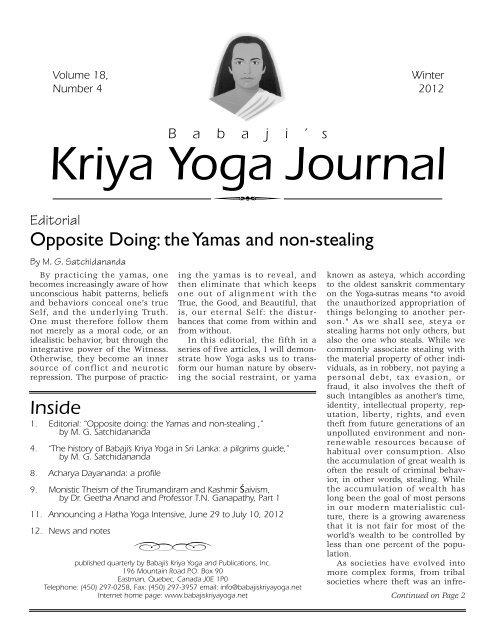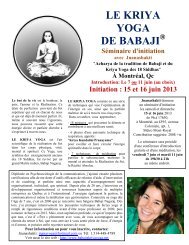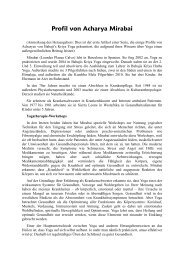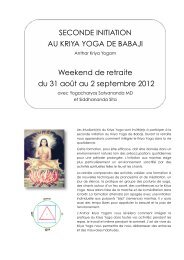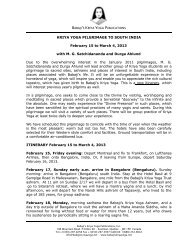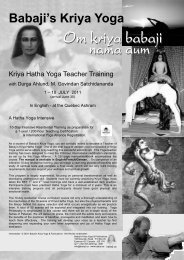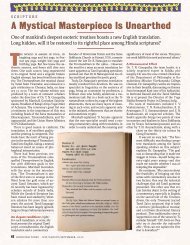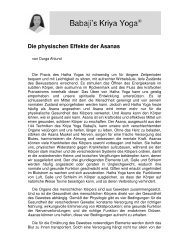Download - Babaji's Kriya Yoga
Download - Babaji's Kriya Yoga
Download - Babaji's Kriya Yoga
- No tags were found...
You also want an ePaper? Increase the reach of your titles
YUMPU automatically turns print PDFs into web optimized ePapers that Google loves.
History of Babaji’s <strong>Kriya</strong> <strong>Yoga</strong> in Sri Lanka: a pilgrim’s guideBy M. G. SatchidanandaMuruga at this powerful shrine and to enjoy the pristinenatural environment. Babaji Nagaraj came here insearch of his Guru, and found the Siddhar Boganathar.Under his guidance, for four years he learned dhyanaand jnana and attained Nirvikalpa Samadhi, with theblessings of Muruga. He also realized that he is anavatar of Muruga.A small shrine has been erected on the very spotwhere Babaji sat, under a banyan tree, with the SiddharBoganathar to attain enlightenment. It is located justinside the gate to the Theivani Amman Kovil. Pujas areconducted there daily by the priests. Devotees areencouraged to meditate and practice <strong>Yoga</strong> in front ofthe small shrine, which contains granite murthis ofBabaji and Siddhar Boganathar and a Muruga vel.Devotees are welcome to visit the Babaji Ashram,which is a 10 minutes walk away from the temple,behind the CTB Government Transport Depot, and thenew bridge. It is located adjacent to the east side of theManickaganga River, in the forest. It is an ideal placefor meditation. Contact in advance: E-mail:srilanka@babajiskriyayoga.netVisitors may enjoy staying at the nearby SunflowerHotel. www.hotelsunflowerlk.net, Tel. 94.47.22.35.611Katirgama temple entranceBabaji’s <strong>Kriya</strong> <strong>Yoga</strong> is a synthesis of <strong>Yoga</strong>Siddhantham, the teaching of the <strong>Yoga</strong> Siddhas. Thissynthesis was created by Babaji Nagaraj, beginningwith what he learned from his first Siddha guru,Boganathar, at Katirgama, Sri Lanka, about 215 A.D.and subsequently from Agastyar at Courtrallam, inTamil Nadu. It is a synthesis of both Classical <strong>Yoga</strong>, asrecorded in the <strong>Yoga</strong> Sutras of Patanjali and Tantra, asrecorded in the Tirumandiram written by the TamilSiddhar Tirumular. Those who wish to cultivate thedevotion for Babaji or to meditate in the sacred environmentin which Babaji’s <strong>Kriya</strong> <strong>Yoga</strong> was born will beinspired to go on a pilgrimage to Katirgama. To do so,what do you need to know?Sri Lanka is a large island off the south east coast ofIndia, with a warm tropical climate. Its name derivesfrom the Sanskrit sri (venerable) and lanka (island), thename of the island in the ancient Indian epicsMahabharata and the Ramayana. It covers 65,000square kilometers (25,000 square miles) and has a populationof 20.6 million. Sri Lanka is next only toMaldives in the South Asian region in terms of percapita income It recorded a GDP growth of 8.2% in2010 and it is estimated that GDP will grow by 9.5% in2011 becoming one of the fastest growing economies ofthe world. It’s population includes about 14.5 millionethnic Sinhala, who are mostly Buddhist, 2.5 millionethnic Tamils, and 1.5 million Moors, who are Muslims.http://en.wikipedia.org/wiki/Sri_Lanka - cite_noteimfsl-4Katirgama Ashram and Babaji Koil templeThe holiest shrine to both Hindus and Buddhists inSri Lanka is the Muruga temple complex at Katirgama,40 km north of the southernmost town in Sri Lanka,Hambatota, deep in the forest, next to theManickaganga River. Every year thousands of pilgrimscome to Katirgama to seek the blessings of LordPage 4How to get there?One may travel to Katirgama by public bus or trainor rental car from Colombo along the scenic coastalhighway, stopping at the beach resort towns of Matara,Galle and Hambatota, and then transfer to a bus going40 km north and inland to Katirgama. This will requireBabaji temple at Katirgamaabout 8 hours. Or if one is short on time and money,take the “Lakehouse Newspaper” bus which leaves at 10pm, from Lake House, in downtown Colombo. Itarrives in the early morning hours at Katirgama via anroute through the interior mountains of Sri Lanka.Continued on Page 4Babaji’s <strong>Kriya</strong> <strong>Yoga</strong> Journal
<strong>Kriya</strong> <strong>Yoga</strong> in Sri Lanka continuedEarly booking can be done at the Lake House to avoiddisappointmentignorance with the light of consciousness. As the holiestshrine in Sri Lanka, people from all walks of faithcome here regularly praying to Lord Muruga for assistancefor all purposes. During the middle of July eachyear, there are elaborate ceremonies over a two period,with fire walking and other ascetic practices by devotees.. It is the only time during the year when thesacred yantra is taken out of the temple – and on theback of an elephant brought down to the ManickagangaRiver for ritual washing.Yogi S.A.A. Ramaiah and the revelationsof Babaji about KatirgamaFrom 1956 to 1968, my teacher, Yogi.S.A.A. Ramaiahmade many visits to Sri Lanka to teach Babaji’s <strong>Kriya</strong><strong>Yoga</strong>. He and his wife Solachi used to stay at theBamballapittya Hindu temple in southern Colombo, onGalle Road, where he would give lectures on <strong>Yoga</strong>Siddhantham and yoga asana classes, and initiationseminars in Babaji’s <strong>Kriya</strong> <strong>Yoga</strong>. He also visited Jaffna,in the extreme north, where he stayed at the home of adisciple, at 51 Arasady Road. In 1958, he also organizedthe fifth annual Parliament of World Religions and<strong>Yoga</strong>, with leading representatives from the variousMonument for Babaji and Boganathar atKatirgamaThe Katirgama temple complex includes three smalltemples, side by side, where Ganesha, Muruga andThevani are worshipped. The entrance gate is framedby a row of carved elephant heads on either side. Tothe right of the Thevani temple is a small Hindu mona -stery, founded by the ascetic Palkudi Baba in the mid19th century. The Babaji Koil or temple, is just behindthe above mentioned wall by another gate leading tothe Thevani temple and monastery. Behind these threetemples lies a huge white Buddhist stupa, over 80 feethigh. A mosque is 100 yards away to the right of thepark in front of the gate. On the left flows theManickaganga River. The entire area is actually aforested park, with ancient trees, devoid of other structures,with no commercial clutter. A powerful spiritualatmosphere pervades the entire area. It is the one placewhere everyone in Sri Lanka comes together in religiousharmony.Buddhist and Hindu priests share responsibility forthe conduct of services in the main temple, which isdedicated to Muruga. Unlike other temples, there is noidol, no image any kind. In fact, the offerings made bydevotees are offered by the priests behind a curtain, toa sacred yantra, which is concealed from the public.This geometric image, carved into stone, is said to concentratethe power of Lord Muruga, the legendary onof Shiva, whose mission is to destroy the darkness ofStudents bathingfaith communities as honored speakers, includingSwami Satchidananda, disciple of the renowned SwamiSivananda. This occurred during a period when communalviolence had broken out between the Tamil andSinhala communities. The government had recentlypassed a law making Sinhala the only official language,and limiting the access to university and civil posts toethnic Tamils. The Parliament attracted hundreds ofContinued on Page 5Babaji’s <strong>Kriya</strong> <strong>Yoga</strong> Journal Page 5
<strong>Kriya</strong> <strong>Yoga</strong> in Sri Lanka continuedpersons from all of the communities. Its message of“unity in diversity” echoed by all the speakers, struck asympathetic chord in the hearts of listeners. The PrimeMinister came to the Parliament and thanked the organizersfor helping to defuse the ethnic tension.During a visit to Katirgama, Babaji directed YogiRamaiah to a huge, ancient banyan tree which wasgrowing in front of the Thevani temple. He told himthat it was under this same tree that Boganathar hasguided him in the practice of dhyana over a period ofnearly 4 years, from the age of 11 to 15. In this place,he attained Nirvi kalpa Samadhi. After doing so,Boganathar instructed him to go to Courtrallam, inTamil Nadu, to find his guru, the Siddhar Agastyar. In1970, Yogi Ra maiah lamented to me that this samebanyan tree had been cut down by a woodcutter a fewyears earlier. But with deep remorse for what he haddone, the woodcutter ended his life by hanging shortlythereafter.However, the roots of the banyan were coming upthrough the nearby well. Yogi Ramaiah began to makeplans to build a small shrine to commemorate thissacred spot.In 1973 he began sending his Western disciples oneby one to live for up to 6 months at a time Colombo, SriLanka, conducting free public yoga asana classes inschools and colleges, and visiting this sacred spot toperform intensive sadhana at this spot. He also foundeda non profit charity known as Lanka Babaji <strong>Yoga</strong>Sangam. These disciples included Edmund Ayyappa,Linga Devar, and Meenakshisunderan. In 1980, heobtained permission from the abbot of the monasterywhich owned the land, to build a temple, the BabajiKoil. A local disciple, Murugesu Candaswamy andMeenakshisunderan, from Baltimore, USA, my longtime<strong>Kriya</strong>ban built the first “Babaji Koil,” was a smallseven foot square concrete structure, housing murthisof Babaji and Boganathar, accessible through a smalldoor. Since that time, the priests from the Thevani templehave performed pujas to these murthis every day,and visitors to the temple complex come to worship.I make my first visit to Sri LankaFrom 1980 to 1981 I spent nearly one year in SriLanka. I lived most of the time in a one room rudimentaryhut, a stone’s throw from the beach and its juncturewith the Welawatte canal separating Colombo fromDehiwala. I made a vow to perform yogic tapas (continuousyogic practice), which included silence, with onlya half hour of reading per day, no forms of distraction,and a weekly asana class for young persons in a localhigh school in Wellawatte, Colombo, and RatmalanaHindu College. The first three months were very difficult,as the mind sought its usual sources of distraction.But then day and night flowed into one another and adeep state of Ananda, or bliss established itself with anexpanded consciousness.Upon the instructions of Yogi Ramiah, upon arrival, IPage 6brought a beautiful fifty pound, two foot high granitemurthi of Vishnu, from Mahabalipuram, India toKatirgama, to replace the one which had been stolenfrom the side of the Thevani temple.This gift was much appreciated by the templepriests. Yogi Ramaiah subsequently informed myselfand Meenakshisunderan, that the abbot of themonastery had also requested him to recommend oneof his disciples, like the author to replace him as abbotas he felt that he was nearing the end of the life. YogiRamaiah indicated that if we wanted to stay inKatirgama for this purpose, it would meet with hisapproval, but that it was for us to decide. The offer wastempting.In late 1980 under the direction of Yogi Ramaiah,and with the support of one of the supreme court justicesof Sri Lanka, the late H.W. Tambiah, who was thechairman of Lanka Babaji <strong>Yoga</strong> Sangam, a half acre parcelof land was purchased across from the beach, at 59Peters Lane, Dehiwala, a half mile from the southernboundary of the capital city of Colombo. MurugesuCandaswamy, who supervised the construction of twosmall houses and the foundation for a meeting hall in1980 and 1981 at this beautiful seaside site.In 1983, communal riots broke out in Colombo, andmany of my friends were murdered by roving gangs ofcriminals. My successor, Eyton Shalom, from New Yorkand Murgesu Candaswamy were forced to quit SriLanka.In 1986, I returned to Sri Lanka with Yogi Ramaiahwith two other disciples, Sita Jean Norton, andChockalingam. An initiation seminar was conductedand we visited Katirgama.During the civil war which began in 1983, a caretakerwas appointed to watch over the ashram inDehiwala. From 1990, he began claiming the propertyfor himself. When Candaswamy returned to Sri Lanka,he had to wage a legal battle for six years before regainingcontrol of the ashram property.In 2002, Murugesu Candaswamy sold two thirds ofthe ashram property including the apartment wherehe lived, to a businessman, to raise funds to build ameeting hall on the remaining portion. Constructionof this began. But in December 2004, after a tsunamiheavily damaged the apartments and construction.Murugesu Candaswamy wrote to me and immediatelybegan a fundraising drive to help finish the constructionMore than $6,000 was raised within a couple ofmonths and sent to Sri Lanka for this purpose. InJanuary 2007, I visited Sri Lanka with my wife Durgaand the kirtan singer, Bhagavan Das, a disciple ofNeem Karoli Baba, and three German sadhaks, Satyaand Nandi and Ganesha. Murugesus Candaswamybrought us to Katirgama where he had purchased a twoacre parcel and built a small ashram, adjacent to theManickaganga river. Bhagavan Das had contributed tothe purchase of this parcel as he wished to build a permanentresidence there. We wre thrilled to see thatBabaji’s <strong>Kriya</strong> <strong>Yoga</strong> Journal
<strong>Kriya</strong> <strong>Yoga</strong> in Sri Lanka continuedwith funds from the sale of the ashram property,Candaswamy had replace the original Babaji temple inKatirgama with a much larger shrine, with an estheticclassical design.From 2006 to 2008, with more funds being sent fromBabaji’s <strong>Kriya</strong> <strong>Yoga</strong> Order of Acharyas in Canada, themeeting hall and new apartments were built at the seasideashram by the newly formed Babaji’s <strong>Kriya</strong> <strong>Yoga</strong>Order of Acharyas Trust, which after the mahasamadhiof Yogi Ramaiah in Malaysia, July 12, 2006, replacedthe then defunct Lanka Babaji <strong>Yoga</strong>Sangam. In 2007, the Order gavescholarships to four students from SriLanka to attend the <strong>Kriya</strong> Hatha <strong>Yoga</strong>Teacher Training course in Bangaloregiven by Durga and myself. Sincethen, three of them, including K.Krishnaveni and T. Anatharavi havecontinued teaching several public<strong>Kriya</strong> Hatha <strong>Yoga</strong> classes every weekin different locations in Colombo, andone of them, Jeyarajeen, teaches freepublic classes in two Hindu templesin Toronto, where he immigrated. Inaddition, since 2006, every year, I orAcharya Satyananda have made giveninitiation seminars in this ashram.and Dhyana.While since ancient times, various communal groupshave competed with one another militarily, politically,and culturally, Babaji’s cherished teaching, “unity indiversity” through the practice of <strong>Yoga</strong>, is helping toheal the fear induced divisions created by political andreligious leaders.An appeal for supportWe are in urgent need of at least $20,000 to buy backRecent and future development ofBabaji’s mission in Sri LankaWith the ending of the 25 year oldcivil war in 2008, conditions in SriLanka have greatly improved. Inorder to help bring the Sinhala and Tamil communitiestogether on the basis of <strong>Yoga</strong>, our Trust has translated,published and distributed several of our publications inthese two languages. Consequently, in October 2011, ofthe sixty persons who attended the <strong>Kriya</strong> <strong>Yoga</strong> initiationseminar, 40 of them were from the SinhalaBuddhist community. Among them was a reveredBuddhist monk. A newly formed Working Committeeof six members from both communities has recentlyassumed responsibility for managing the activities ofthe Trust. These include free public yoga classes, pujas,and satsang meetings of initiates, every week, the organizationof pilgrimages to Katirgama, and the translationand publication of books on <strong>Kriya</strong> <strong>Yoga</strong> into theSinhala language. For details contact K. Krishnaveni at(94)-(0)7.73.70.69.88The Babaji shrine in Katirgama has recently beenrenovated with a new ceramic tile surface. A granitemonument, with an inscriptions in Sinhala, Tamil andEnglish now commemorates this sacred site. A mandapamportico will soon be constructed at its entrance toprovide shade. Plans for a meditation hall to its rearhave been prepared. Everyone is invited to visitKatirgama and to worship either externally with puja orinternally by practicing <strong>Kriya</strong> Kundalini PranayamaSinhala and Tamoul students at the October 22-23, 2011 seminarthe land adjacent to the new meeting hall from thebusinessman who purchased it in 2003. Following thedestruction caused by the tsunami, new governmentrestrictions on the sale of property along the seaside,prevented the new owner from developing it. However,these restrictions are expected to end soon. More fundswill be needed to develop the Katirgama meditationhall and ashram. We are therefore appealing to everyoneto send donations which will be used to buy backthe ashram land at 59 Peters Land, Dehiwala. This willensure that our ashram will continue to be a peaceful,ideal place for the instruction and practice of Babaji’s<strong>Kriya</strong> <strong>Yoga</strong>. For this purpose, donations may be madeto Babaji’s <strong>Kriya</strong> <strong>Yoga</strong> Order of Acharyas in Canada,directly by cheque, credit card on our websiteOrder/Contributions page, or by bank transfer. Donorsliving in North America will receive a receipt whichcan be used to deduct the amount of their donationfrom their taxable income. Donors from India mayeither donate for this purpose through our BangaloreTrust or directly to the Trust in Sri Lanka. For furtherdetails, write to me at satchidananda@babajiskriyayoga.netor srilanka@babajiskriyayoga.net or info@babajiskriyayoga.inor contact Murugesu Candaswamy at(94) 785.796.395. Babaji’s <strong>Kriya</strong> <strong>Yoga</strong> Journal Page 7
ProfileAcharya DayanandaI was invited to write a biography and to talk aboutmy relation with <strong>Kriya</strong> <strong>Yoga</strong>ChildhoodI was born December 17th 1953 in Montréal,Québec, Canada. Since a very young age I was alreadyvery attracted to spirituality.My parents and especiallymy paternal grandfather was a very religiousman. He wouldn’tmiss any opportunity toparticipate in a pilgrimageor to prayer. He wasmember of a CatholicFranciscan order and heloved wood carving forhours. He completed severalreligious sculpturesfrom the Saints, Jesusand the Evangelists forthe Church, friends orhimself. He had even carved a rosary with big seedsand on each one there was a religious scene, a magnificentwork. My spiritual relationship with him beganwhen i was three years old. I would run away from myhouse to visit him, as he lived just next door. I loved tohear him telling me the stories of the saints, includingSaint François of Assisi and brother André to whom hewas deeply devoted.At 6 years old when people asked me what would ilike to do latter I used to answe “I want to become amarried monk”. This doesn’t exist in Catholicism. Onecan do nothing when the call is there it remains forever. As we can read in the book The Voice of Babaji : «One cannot benefit from something if one is not readyto receive it. All growth comes from within.’’ Later onmy grand father fulfilled my need for spiritual literatureoffering and lending me several religious books.When I was a child I loved to recite prayers and later atthe age of thirteen during a dream a Goddess revealedherself and taught me a mantra: “Om Namo BhagavatheVasu Devaya.” By that time I didn’t know its origin norsignificance but enjoyed repeating it continuously.Ever since, I enjoy repeating mantras without anyeffort, like a second nature.Spiritual seekingMy mother became a Jehovah’s Witness when I wassix years old and since this time I began to read everythingthat I could about this religion. Some years latterI began to compare different religions. My mother withoutknowing had opened the door of all religions to me,awakening my everlasting curiosity and thirst for truth.At the age of fourteen I read so much on Buddhism,Page 8Acharya DayanandaIslam and Christianity, as well as Hinduism. I beganpracticing meditation and exercises in relaxation andastral travel. I wanted to demonstrate that no matterwhat one’s religion is, it is people who make the divisionsand that it is God who as the absolute ruler cannotbe limited by a book, a region of the word, a peopleor a religion. Being a Catholic, I was told that God hadwritten only one book, the Bible. As I saw that it wasseveral ordinary persons who wrote such a hugeamount in this book, for me, God could not be so small.I understood that in all of the authentic texts of asceticismand mystic Christianity or others which I read,the same thing was repeated. On must practice, masterthe mind, examine and correct one self. They all leadto the same goal: the Divine, but that each used differentnames: God, Self, Soul, the Supreme and others.This was the beginning of my search for Truth.<strong>Kriya</strong> <strong>Yoga</strong>In the early 1980’s I read The Autobiography of aYogi and enrolled in the correspondence course of theSelf Realization Fellowship. I was a part of this movementand several others for many years. In 1983, afriend invited me to attend a meeting where <strong>Kriya</strong> <strong>Yoga</strong>was being practiced, on Querbes Avenue in Montreal. Itwas there that I met for the first time an authentic yogiwho, in my opinion, had gone beyond the theory andput into practice the teachings of his master. No matterwhat question one put to him, he turned me backtowards the importance of practice. What came out ofhis mouth, was “practice, practice and practice,” andnothing more. His name was Govindan, and he nowknown as Satchidananda. During this period he woreonly Indian cloth like Mahatma Gandhi, something younever saw in Quebec. He conducted scheduled satsangmeetings even when I was alone with him. Overall, atrue and authentic person who lived in simplicity, withoutany pretence, concentrated on what was essentialwith great detachment. Before being a good master onemust first be a good disciple and it is exactly what thisyogi did; and I am here to bear witness to his devotionto his guru S.A.A. Ramaiah. As incredible as it mayseem now, he had a very beautiful voice, clear andstrong, which made us appreciate the mantras andsacred chants.Later, in November 1986, my nine year old son diedwhen our house burned. This was a terrible event, butdespite the pain, I received my first initiation intoBabaji’s <strong>Kriya</strong> <strong>Yoga</strong> in December 1986 in Washington,D.C. by Yogi S.A.A. Ramaiah. He told me that he hadlost his wife in India, and that despite everything, losingeverything in fire was a great purifying force. Mymeeting with him and my initiation helped me to getContinued on Page 9Babaji’s <strong>Kriya</strong> <strong>Yoga</strong> Journal
Monistic theism of the Tirumandiram and Kashmir ŚaivismDr. Geetha Anand and Prof. T.N. GanapathyPart 1(Editor’s note: We will soon publish the 2nd edition of“The <strong>Yoga</strong> of Tirumular: Essays on the Tirumandiram.” Atmy request, Dr. Ganapathy and Dr. Geeta Anand have writtenfor it a new final chapter, 33 pages in length, which discussesthe debate over whether the Tirumandiram advocatespluralistic realism or monistic theism. Essentially the debateboils down to the question of “Are there three eternalrealities: God, the soul and the world? Or is there really onlyOne, all else being merely an illusion?” This chapter alsocompares the school of Kashmir Shaivism to theTirumandiram, because both advocate a perspective whichbridges the above two competing viewpoints. In this first in aseries of three articles, excerpts from this chapter are presented.This chapter contains three sections. The first article containsselected verses to show that the burden of the song of theTirumandiram is monism only. The second article in thenext issue will give a brief account of Kashmir Śaivism representingit as a Śaivite model of monism. The third article willshow the parallelism between the Tirumandiram andKashmir Śaivism to emphasize the viewpoint that theTirumandiram advocates monism and monism only. Thisparallel study is an unexplored field hitherto. By using theterm ‘parallelism’, it is suggested that there might have beenno known historical, literary or philosophical interactionbetween the two systems and that there is no concrete evidenceso far to say that either system has influenced theother.)IntroductionThe necessity and need for writing this additionalchapter in the second edition of The <strong>Yoga</strong> of SiddhaTirumular: Essays on the Tirumandiram arises sincemany readers may not know that there is a debate withinthe Śaiva Siddhānta, whether the Tirumandiram representsmonistic theism or pluralistic realism. Thisdebate has been included in full in the Tenth volume ofthe English translation of the Tirumandiram, edited byT.N. Ganapathy and published by Babaji’s <strong>Kriya</strong> <strong>Yoga</strong>Order of Acharyas, Quebec, Canada (January 2010). Thearticle under the title “Monism and Pluralism in ŚaivaSiddhānta” by Subramuniya Swami of the HawaiiSchool maintains that the Tirumandiram advocatesmonistic theism while the article “There can be only oneContinued on Page 10Profile continuedthrough this difficult period in my life. In November ofthe following year I was initiated into the second levelof <strong>Kriya</strong> <strong>Yoga</strong> in Yuma, Arizona again by Yogi S.A.A.Ramaiah. Since then, I have repeated the initiations, Ihave never ceased to put into practice the teachings.On June 24, 2007 I was inducted into Babaji’s <strong>Kriya</strong><strong>Yoga</strong> Order of Acharyas in a ceremony conducted by M.G. SatchidanandaRecentlyIn 2005, during my first voyage to India, I had theimpression of having returned home after a longabsence. It was so great to find myself in a countrywhere spirituality was omnipresent. In 2009, I retiredfrom a career as a manager in Montreal’s transit authorityfor public transport, and plunged into a new positionin the company of my wife. She owned a half wayhouse for those who had lost their physical independence,and together we transformed it into a residencefor those who have lost their cognitive autonomy fromAlzheimer’s disease, and for which there is a growingdemand. This work required complete involvement forboth of us. We worked long hours for months to fulfillthe functional requirements of such a residence. Theadventure was very beautiful on several levels. It mademe understand the word of Lord Krishna in theBhagavad Git: “Do your duty, but leave the fruit of youractions to me.” People who suffer from this diseasehave no recollection of who you are . The work has tobe repeated every day, with no recognition, and that isvery good like that. Being with such persons moves usto live in the present moment.TodayNow that my wife and I have agreed to sell this residencefor the mentally handicapped in order to begin anew phase in our lives, we have purchased a parcel ofland 250 meters from the entrance of the Quebecashram. We intend to build our home and live there,taking charge of part of the activities of the ashram.Doing so, I am dedicating my time to sharing spiritualand wisdom teachings, through classes, lectures, seminarsand other activities. Through Babaji’s <strong>Kriya</strong> <strong>Yoga</strong> Iwish to share my humble experience. My deepest wishis to make the spiritual path as clear as possible in theminds of others, so that they can avoid many detours.For me, spirituality must be open to everyone with barriersdue to race, religion, country, age, etc.The goal of life is to dedicate oneself completely tobecoming the perfect instrument for the Divine, realizingself fulfillment, and finally dissovlving oneself intothe universal self. Our sole obstacle is the ego, which isnothing other than the identification with the bodyand with movements in the lower mind. As one meandersthrough life one must not forget that only the selfexists and that nothing can affect or destroy it. Also,that finally, Truth is omnipresent, all around us, andwithin us. We have only to seize it, nothing ever havingbeen hidden. OM KRIYA BABAJI NAMA AUM OMTAT SATBabaji’s <strong>Kriya</strong> <strong>Yoga</strong> Journal Page 9
Monistic theism continuedFinal conclusion in Śaiva Siddhānta” by T.N.Arunachalam maintains that the Tirumandiram advocatespluralistic realism only. Now the contention of thedebate is whether the Tirumandiram advocates monismor pluralism. A deeper study of the Tirumandiram willclearly show that the practice of Śiva <strong>Yoga</strong> as advocatedin it is much closer to monistic theism, rather than pluralisticrealism. This inclusion of the additional chapteris necessitated by the fact that the third chapter in theEssays on the Tirumandiram entitled “Saivism as conceivedin the Tirumandiram” puts forth the view thatthe Saivism of Tirumular is pluralistic realism.The co-authors of this essay strongly feel that theTirumandiram advocates monism only. In support ofthe view, they take into consideration important versesfrom the Tirumandiram to show that the work standsfor monism rather than pluralism. To show that it isadvaitic (not Śankara’s Advaita of mayavāda which islater in origin) in spirit rather than pluralistic inapproach, a parallelism has been instituted between theTirumandiram and Kashmir Śaivism.Monistic view of the TirumandiramThe refutation of the monistic view of theTirumandiram by an article “There can be only onefinal conclusion in Śaiva Siddhanta (according toThirumular)” which is the Dharmapuram Ādhinam’sreply to the article “Monism and Pluralism in ŚaivaSiddhanta” by Subramuniya Swami, a Hawaiian Śaivite,reminds one powerfully of “The Refutation of Idealism”by G.E. Moore 1 . The issue between monism and pluralismis an age-long one in philosophy, both in the Eastand in the West, right from the days of the Vedas andthe Greeks to the modern present day. Still, the debategoes on and probably the issue is unsolvable. Hence,instead of arguing about monism and pluralism in generalthe present issue is confined to the Tirumandiram,whether it advocates monism or pluralism as “there is agreat debate, nay, a battle going on between the two differentgroups” of Śaiva Siddhanta. This present essay isan attempt in the defense of monism of theTirumandiram without entering into the details, forwhich the two articles may be referred to.Before discussing whether the Tirumandiram advocatesmonism or pluralistic theism let us discuss some ofthe features of the Tirumandiram that convince us that itis, at the outset, a Siddha work conveying monism.According to the Tamil Siddhas or the realized souls,the ultimate goal of life is attaining cosmic consciousnessfrom which everything derives and to which everythingreturns. This ascent into the cosmic consciousnessis to descend into one’s own self. As Bhadragiriyar says,self-realization is “knowledge which knows knowledgethrough knowing knowledge” (Bhadragiriyar Pulambalverses 192 and 23). Tirumular says that any knowledgewhich does not help man to know himself is false orpseudo-knowledge.Knowing oneself is indeed true knowledge.Page 10Knowing other things is the devil’s knowledge(mandiram 2318).In another mandiram, he says that a self-realized personwins eternal life.To know his own self there is no decay of himKnowing not his own self he decaysHaving known the knowledge of his own selfHe existed to be adored by others. (mandiram 2355)The Tamil Siddhas relied on the individual’s effort forthe attainment of liberation. The Tirumandiram, whichis an offshoot of the pan-Indian Tantric tradition, insistson the value of Tantric <strong>Yoga</strong> as a means for the attainmentof freedom and immortality. Liberation, moka, orvīdu (in Tamil) is a mystical state referred to as <strong>Yoga</strong>samādhiby Tirumular.Inside the Yogic samādhi is the infinite space;Inside the Yogic samādhi is the infinite light;Inside the Yogic samādhi is the omnipotent energyYogic samādhi is what the siddhas are fond of.(mandiram 1490)As a Tantra Śāstra, the Tirumandiram insists on thesupreme importance of jñāna, wisdom, or that, whichcould be loosely translated as knowledge. According toTirumular, jñāna bestows liberation.No ethical path excels in the world other than jñānaThat religion is not good which rejects jñānaNothing yields liberation other than jñānaThose endowed with jñāna outshine their fellowhumans. (mandiram 1467)Jñāna gives ‘oneness’ whereas bhakti or devotiongives fellowship.As a Tantra work, the Tirumandiram began a newtradition in Tamil. Tirumular calls his yoga as Śiva yoga.Śiva yoga distinguishes cit from acit;Penance of <strong>Yoga</strong>-deep (tava yoga), Śiva’s effulgence inone’s own selfShunning wrong paths (ava-yoga); great bliss of lovedelights;New <strong>Yoga</strong> (nava-yoga) this is! Nandi gave us. (mandiram122)He calls Śiva yoga as a new type of yoga (nava-yoga).By calling it as nava-yoga, Tirumular indicates that thistype of yoga was not in vogue before him in the Tamilcountry. It is only in the Tirumandiram that this (Śiva)yoga is being explicitly explained and discussed for thefirst time. Though Tirumular does not use the expressionKundalini yoga in any place in the Tirumandiram,what is discussed as Śiva yoga by him is actually theKundalini yoga, as he speaks of cakras, prānāyāma,pariyanga-yoga, sūnya sambhāanai (twilight language),etc. We may, therefore, safely say that theContinued on Page 11Babaji’s <strong>Kriya</strong> <strong>Yoga</strong> Journal
Hatha <strong>Yoga</strong> intensive, June 29 to July 10, 2012With Durga Ahlund and M. Govindan Satchidananda at the Quebec AshramAs a student of Babaji’s <strong>Kriya</strong> <strong>Yoga</strong>, you are cordiallyinvited to become a Teacher of Babaji’s <strong>Kriya</strong> Hatha<strong>Yoga</strong>! One of the best ways to deepen your own practiceof <strong>Kriya</strong> <strong>Yoga</strong> and to serve others is by teachingthis wonderful scientific art. This <strong>Yoga</strong> teacher traininghas been designed to meet the 200-hour Internationalcertification standards, as set up by the <strong>Yoga</strong> Alliance.A 250-page manual/workbook accompanies the course.On completion of an intensive 10-day residential training,you will begin a year-long process of teaching andstudy of spiritual texts and complete a final exam,which will not only fulfill training requirements, butalso support your wellness and spiritual growth.This program is largely experiential, focusing on personaltransformation as well as developing professionalskill. Students must be currently practicing <strong>Kriya</strong> <strong>Yoga</strong>,have taken the BKY 1st and 2nd level trainings andhave a well-established daily practice. Participants musthave practiced Hatha <strong>Yoga</strong> for a minimum of two years.This is an intensive training program and all participantsshould have good physical and emotional health.The 10-day residential course curriculum covers notonly a thorough understanding of the mechanics of the18 asana of <strong>Kriya</strong> Hatha <strong>Yoga</strong>, but also how <strong>Yoga</strong> works.You will learn the physical benefits and the theorybehind the asana selection and what occurs energeticallyas you practice them. The course is comprehensive.The curriculum covers workshops on physical andsubtle anatomy and physiology, pranayama (<strong>Kriya</strong>sand additional techniques), bandhas and mudras, meditation,self-study and philosophy. You will learn how toteach all of these elements of <strong>Yoga</strong> effectively. Thetraining will develop your voice as a teacher by firstdeepening and expanding your own Inner experienceand joy of Hatha <strong>Yoga</strong> and meditation. Instructors:Durga Ahlund, Marshall Govindan, Pierre Desjardins.The program begins in the evening of June 29 andends in the morning of July 10, 2012For more information contact durga@babajiskriyayoga.netMonistic theism continuedTirumandiram is the first treatise in Tamil which dealswith the different aspects of Kundalini yoga under thename Śiva yoga.One does not find any reference in the Tirumandiramthat Tirumular worshipped any individual deity in anyparticular temple. His reference to Chidambaram in hiswork is not a reference to a place but to ciambalam i.e.,microcosm. His reference to Nataraja stands for themanifestation of primal rhythmic energy. AsVellaivaranan says in his article on Tiru-t-tillai inTirumuais, the word chidambaram occurs only in theTirumandiram and nowhere in the eleven Tirumuais. Inthis work, he does not seem to have sung in praise ofgods and goddesses of local temples as done by the laterNāyanmars and Āwars. This is a significant feature thatdistinguishes Tirumular from the pluralistic saints ofŚaiva Siddhānta and includes the Tirumandiram in thecategory of monistic Siddha works. Even thoughTirumular speaks of the religious aspect of God, hebelieved in a Supreme Abstraction, a “Great Aloneness”.His expression for this is tai-ua- kevalam (mandiram2450). This is Śivam without any limitations or attributes.Śivam is grammatically and philosophically animpersonal conception. As Siddhas say, the ideal namefor Sivam is ‘It’, adu, Thatness’, Suchness’, orParāparam Śivam is not a personal God. It is a practice,an entryway. It is a foundational consciousness orawareness. This attainment of awareness or Śiva-consciousnessis mukti or liberation. A deeper study of theconcept of Śivam would reveal that it took two channelsin Indian thought, one theistic with a personal or devotionalrelationship to God based on the method of bhaktiand the other Tantric, i.e., absolutist, based onKundalini <strong>Yoga</strong> and jñāna. The bhakti method is a pluralisticone as reflected in the Śaiva Siddhānta school; theabsolutistic method is the monistic one as reflected inthe Tirumandiram.This preamble indicates that the Tirumandiram is aTantra work that is monistic in spirit and content. As aSiddha work, it leans towards viewing the Absolute as anon-dual entity. In philosophy, there are two types ofontology- explicit and implicit. Explicit ontology isbased on the theistic conception of God, God as a person,whereas implicit ontology is based on the notion ofthe Absolute, not as a person but as a principle andvalue, as an Absolute Freedom or as Tirumular says “AGreat Aloneness”. The ontology of the Tirumandiram isimplicit in nature, that which leans towards monismrather than pluralism. Though much may be said onboth sides, the Tirumandiram is monistic in tone andcontent.(to be continued)Babaji’s <strong>Kriya</strong> <strong>Yoga</strong> Journal Page 11
News and NotesBadrinath Ashram constructionprogresses We are happy toannounce that constructionresumed September 6, 2011,afteran interruption of eleven months.The State of Uttarkhan imposed aBadrinath Ashram construction, November 2011ban on all construction in themunicipality of Badrinath inAugust 2008, shortly after weobtained a building permit. Inspiteof the ban, we had managed tocomplete most of the foundationand 63 pillars to the second floor ofthe apartments, before the governmentofficers began strictly enforcingthe ban in early October 2010.While the ban is still in effect, ithas been “relaxed” due to upcomingelections, and we have beengiven a green light to continue.During our pilgrimage to BadrinathOctober 4-15, 2011, everyone of the26 pilgrims helped to complete theconcrete slab ceiling above the firstsix appartments. See the photos.We are very hopeful that these firstsix appartments will be completedby October 2012. Our next pilgimageto Badrinath will be in October2013.Second level initiations will begiven by M.G. Satchidananda inQuebec: June 15-17, 2012.Third level initiations will beoffered in Quebec July 13 to 22,2012 and in BrazilNovember 14-22,2012, with MGovindan. Attain thegoal of Self-realizationwith powerfulkriyas to awaken thechakras and to gointo the breathlessstate of samadhi.Silence Retreat:June 20 to 25,2012 at the Quebecashram with Daya -nanda, Sat chid -ananda and Durga.For the program seethe website www.babajiskriyayogal.net.Visit Durga’s blog www.seekingtheself.com.Work study program at theQuebec ashram Initiates are invitedto participate in this program in2012, for a period between oneweek and three months. In returnfor 25 hours per week of karmayoga, lodging and a meal allowanceis provided. For more informationwrite to satchidananda@babajiskriyayoga.net.Visit our e-commerce sitewww.babajiskriyayoga.net for purchasingwith your VISA, AmericanExpress or Mastercard all of thebooks and other products sold byBabaji’s <strong>Kriya</strong> <strong>Yoga</strong> Publications, orfor donations to the Order ofAcharyas. Your credit card informationis encrypted and kept secure.Check it out!Most back issue articles of the<strong>Kriya</strong> <strong>Yoga</strong> Journal are now beingadded to our website: Info@babajiskriyayoga.netGo check themout.We request all of our subscribersin the Euro currencyzone to send annual subscriptionpayment of 12 Euros in a chequepayable to “Marshall Govindan in atransfer, to Deutsche Bank,International, BLZ 50070024,account no. 0723106, re. IBANDE09500700240072310600,BIC/Swift code DEUTDEDBFRA.(Or in francophone countries ofEurope, le paiement doit être faitau nom de « Marshall Govindan »dans un transfert à la BanqueCrédit Lyonnais, Banque 30002,indicatif : 01853, numéro decompte 0009237P80, re. IBAN FR753000 2018 5300 0000 9237 P80, BICCRLYFRPP or a cheque payable to“Marshall Govindan,” sent toFrancoise Laumain, 50 rueCorvisart, 75013 Paris, France. InSpain, send a cheque payable to «Nacho Albalat at c/ Ruzafa 43/2,Valencia 45006, Spain and informhim at hunben@gmail.com. Ger -man speaking countries informPrem at prem@babaji.de to renewyour subscription.To renew the English language editionof the <strong>Kriya</strong> <strong>Yoga</strong> Journal,please do so via the bookstore sectionof our website www.babajiskriyayoga.netor by sending acheck payable to Babaji’s <strong>Kriya</strong><strong>Yoga</strong>, with the Renewal Form onthe next page.Page 12Babaji’s <strong>Kriya</strong> <strong>Yoga</strong> Journal
Notice to SubscribersThe journal will be sent by email to everyone who has an emailaddress. We request that all of you inform us of the email addressto which you would prefer we send the journal, and if you areusing an anti-spam blocker, to put our email address info@babajiskriyayoga.neton the exception list. It will be sent as a formattedwith the photographs in a PDF file attachment. This can be readusing Adobe Acrobat Reader. Otherwise it can be resent uponrequest in a Word file, unformatted with no photographs. If youdo not renew before the end of March 31, 2012 you may notreceive the next issue:Renewal FormPlease renew my one-year subscription to “Babaji’s <strong>Kriya</strong><strong>Yoga</strong> Journal”NameAddressemailEnclosed is a check for US$12 or Canada: Cn$13.65 or Quebec:Cn$14.95 payable to “<strong>Babaji's</strong> <strong>Kriya</strong> <strong>Yoga</strong> And Publications, Inc. “196 Mountain Road, P.O. Box 90, Eastman, Quebec, CanadaJ0E 1P0.Babaji’s <strong>Kriya</strong> <strong>Yoga</strong> Journal Page 13


